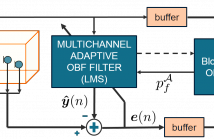
- Read more about Unsupervised Speaker Adaptation of BLSTM-RNN for LVCSR Based on Speaker Code
- Log in to post comments
Recently, the speaker code based adaptation has been successfully expanded to recurrent neural networks using bidirectional Long Short-Term Memory (BLSTM-RNN) [1]. Experiments on the small-scale TIMIT task have demonstrated that the speaker code based adaptation is also valid for BLSTM-RNN. In this paper, we evaluate this method on large-scale task and introduce an error normalization method to balance the back-propagation errors derived from different layers for speaker codes. Meanwhile, we use singular value decomposition (SVD) method to conduct model compression.
- Categories:
 11 Views
11 Views- Read more about ESTIMATION OF TDOA FOR ROOM REFLECTIONS BY ITERATIVE WEIGHTED L1 CONSTRAINT
- Log in to post comments
- Categories:
 13 Views
13 Views- Read more about ESTIMATION OF TDOA FOR ROOM REFLECTIONS BY ITERATIVE WEIGHTED L1 CONSTRAINT
- Log in to post comments
- Categories:
 17 Views
17 Views- Read more about Characterization and Classification of Sonar Targets Using Ellipsoid Features
- Log in to post comments
We present a geometry-inspired characterization of
target response for active sonar that exploits similarity between
intra-class features to distinguish between different targets
against environmental objects such as a rock. Key innovation is to
represent feature manifolds as a set of ellipsoids, each of which
geometrically encompasses a unique physical characteristic of
the target’s response. We have demonstrated over experimental
field data that for a given target class, these feature ellipsoids
- Categories:
 25 Views
25 Views- Read more about Room Shape Reconstruction With a Single Mobile Acoustic Sensor
- Log in to post comments
- Categories:
 22 Views
22 Views
- Read more about Natural Sound Rendering for Headphones: Integration of signal processing techniques
- Log in to post comments
With the strong growth of assistive and personal listening devices, natural sound rendering over headphones is becoming a necessity for prolonged listening in multimedia and virtual reality applications. The aim of natural sound rendering is to naturally recreate the sound scenes with the spatial and timbral quality as natural as possible, so as to achieve a truly immersive listening experience. However, rendering natural sound over headphones encounters many challenges. This tutorial article presents signal processing techniques to tackle these challenges to assist human listening.
- Categories:
 29 Views
29 ViewsPages
- « first
- ‹ previous
- 1
- 2
- 3
- 4
